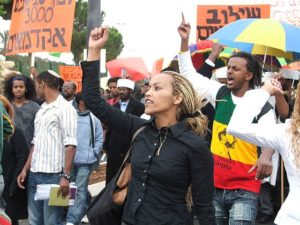Playlist
Show Playlist
Hide Playlist
Individual vs. Institutional Discrimination – Discrimination (SOC)
-
Slides Discrimination SocialInteractions.pdf
-
Download Lecture Overview
00:00 Okay. Let’s talk about discrimination now. 00:03 This is a social construct that happens. Whether you like it or not, you yourself might employ it. 00:11 It’s probably happen to you at some point. 00:13 And we’re going to look at it so start off by looking at two different types of discrimination. 00:17 So the first one would be Individual Discrimination. 00:19 Now this is when an individual treats another negatively in different from the others with a that group. 00:25 It involves exclusion or restriction of others from different opportunities. 00:29 It’s a fancy way of saying, you are solely picking out an individual and discriminating them or choosing certain qualities that they might have against them. 00:41 And threating them restricting them from certain opportunities. 00:45 Okay so, we will look at what are some of those characteristics or factors Which you can immediate this discrimination. 00:50 So some of them are fairly obvious. Things like race, gender, culture, sexual orientation, age. 00:57 These are all things that you can sort of pick out and say well based on that race, I’m going to discriminate or exclude them from what I’m doing over here. 01:07 So again, some are required obvious the color of your skin, whether male or female, sexual orientation. 01:13 You know, I don’t like gays. And so, therefore, I don’t want them and working in my place. 01:17 Or I don’t want to be around gay people or homosexuals or I’m really not able to relate to adults. 01:25 I like strictly hanging out with teens, or different cultures. 01:30 I don’t like Muslims or I don’t like Catholics. 01:34 And you can pick and choose always in different things. 01:36 So, and this is just a sampling of the potential discriminators, which can be used. 01:41 So, there’s so many different characteristics that you can pick and choose on. 01:45 And sometimes you can even have over layer are combination of a couple of this. 01:49 So, this is sort of an example of where you can use this discrimination to explain altruistic behaviors, in terms of how they can influence natural selection. 02:01 And that, you are going to try and exclude certain individuals in order to improve sort of your chance for success. 02:09 And this a little bit in terms of the definition of altruistic behaviors and the traditional send of trying to be selfless to help others. 02:16 This is trying to help the success of your say culture or group versus an individual. 02:24 So you’re discriminating in order to help your chances of success. 02:27 Now, let’s take a look at Institutional Discrimination. 02:32 So we just discuss individual. Institutional looking at the discriminatory practices employed by large organizations. 02:38 And these are practices that are imbedded in the organizational culture and operating procedure. 02:43 What we’re saying here is large big bodies. And then again, this is a stereotype. 02:48 It’s not at all large institutions do this but some can employ written, they usually have a written but unwritten discriminatory rules. 02:58 So they’ll do things in order to exclude certain groups. 03:02 They might do things like incent you doing thing on a certain way. 03:07 Which ends up excluding others. 03:09 You know, they can have don’t ask, don’t tell type of policies saying, “Well, I’m just going to turn my head if you do what you going to do.” It could be, again, going back to the same features that we’re look at the characteristics saying things like, “I’m interviewing for a new position.” And you’re the manager, and you’re going to interview to these people. 03:29 And you have 10 applicants. And they’re two that are really well qualified. 03:33 and there are about equal but in the resume or asking around references, you establish that one of them might be gay or lesbian. 03:44 And so based on that characteristic, you say, you know what, I – around here we don’t need a homosexual working with us. 03:52 So I’m going to now discriminate and not hire that person. 03:55 And they’re not going to advertise, saying, why didn’t I get the job? Well, you didn’t get the job because you’re gay. That really wouldn’t work out. 04:03 That would be all over the news and rightfully so. 04:06 But if you have that sort of unwritten and just say, “Well, no.” we had another a more qualified candidate.” That’s not necessarily the truth, but that’s what they’re going with. 04:16 And so, that type of discrimination can shape and shift the culture within that organization. 04:21 Who’s going to be hired? And they tend to then kind of hire those that are like-minded. 04:26 Alright, so if you keep those people out, whether by its gender or race, And you’ll say, we’re going to create and culture that where everybody aligns in their thinking. 04:38 That would classify institutional discrimination.
About the Lecture
The lecture Individual vs. Institutional Discrimination – Discrimination (SOC) by Tarry Ahuja, PhD is from the course Social Interactions.
Included Quiz Questions
What is the term for unfair treatment directed against a person?
- Individual discrimination
- Differentiation
- Intersectionality
- Symbolic racism
- Racism
What do you call the inequality woven into the fabric of society by organizations and social structures?
- Institutional discrimination
- Individual discrimination
- Racism
- Symbolic racism
- Intersectionality
Customer reviews
5,0 of 5 stars
| 5 Stars |
|
5 |
| 4 Stars |
|
0 |
| 3 Stars |
|
0 |
| 2 Stars |
|
0 |
| 1 Star |
|
0 |




